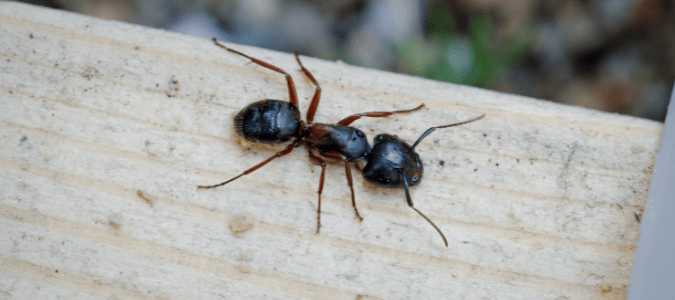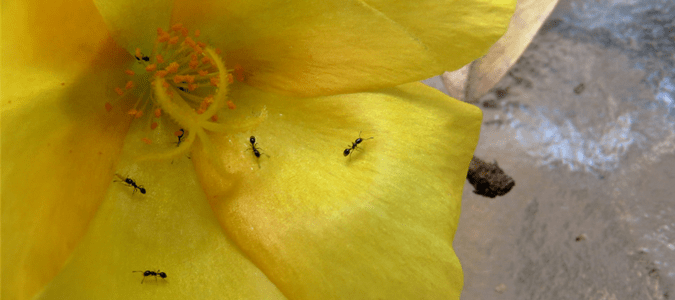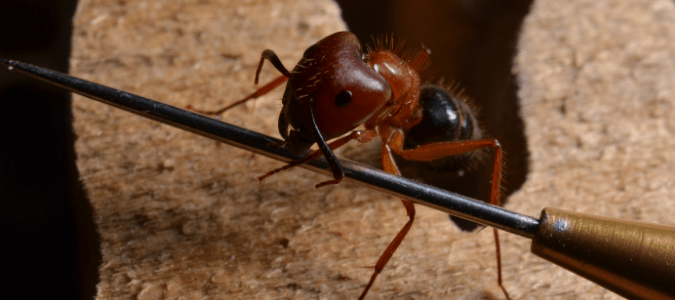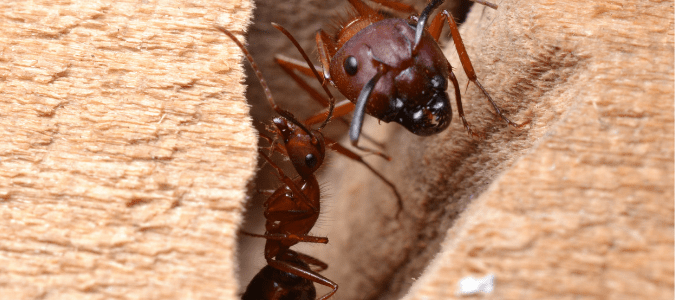Finding ants in your kitchen, bathroom or other areas of your home is a pain. There always seems to be more of them after the first one is dealt with. Most of the time they’re just a nuisance. But, some species like carpenter ants can seriously damage the structure (and value) of your home.
At first glance, it can be difficult to notice the differences between species like the common black ant and the carpenter ant. However, there are a few key features that can help you determine which is in your home.
Carpenter Ants
Carpenter ants, pictured above, are big black ants and typically around a half of an inch long. While they are most often black, they can also be red, brown or a combination of those colors. Known for their powerful jaws and painful bites, carpenter ants inject a bite wound with formic acid. This is what causes an intense burning sensation. The pain is brief, however, and subsides without any ongoing threat to health or safety.
A mature carpenter ant colony will average between 10,000 to 50,000 individual ants. The size of the colony will depend on the physical size of the nest. Additionally, each colony includes one wingless queen.
They are named after their destructive tendencies of excavating tunnels by chewing through wood to create these nests. However, despite common misconceptions, carpenter ants don’t actually eat wood. They simply bore through it to create tunnels, leaving the remaining (and structurally weakened) wood in their wake.
The carpenter ant’s diet consists mainly of plant juices, fruit juices, small insects and honeydew, a rich sweet liquid secreted by aphids and related insects. In fact, ants will actually “farm” aphids in return for the honeydew they produce. Caring for them by protecting the aphids from natural enemies like ladybugs and spiders, and moving them to healthy plants to feed. Ants will even “milk” their aphids by stroking their abdomens until they secrete honeydew.
In areas with human populations, carpenter ants are happy to abandon their normal diet and replace it with sweets, meat, eggs and grease left available by people.
When it comes to the destructive abilities of carpenter ants versus black ants, carpenter ants win (and homeowners lose) every time.
Due to their destructive nature, homeowners should contact a professional as soon as they see carpenter ants. A professional can perform an inspection and confirm the species of ant. Then, they can implement effective ant control measures.
Common Black Ants
Common black ants are also sometimes referred to as little black ants (monomorium minimum). They are substantially smaller than other species of ants, averaging just 3 to 5 millimeters in length (1/16-inch). The queen black ant can be as much as twice this size.
The common black ant lives throughout North America. Despite its name, these ants can range from a glossy black to dark brown or even mahogany in color. Black ant colonies average 4,000 to 7,000 ants, though larger nests have been found housing as many as 40,000. Larger nests, which have been around for multiple generations can encourage larger-sized black ants, as well.
Common black ants share the same diet as their carpenter cousins, right down to their symbiotic relationship with aphids. Likewise, these ants eat food scraps, garbage, and the leftovers from our tables and counters, especially sweets. This is why they are commonly referred to as “sugar ants” as well.
Unlike carpenter ants, the common black ant isn’t interested in wood, or creating tunnels. But, they will move entire colonies in search of a reliable source of food and water. When they find it (even in your home), they are likely to establish themselves for the long haul.
In the outdoors, they prefer dark, hidden areas that offer protection, like fallen trees, large stones, piles of bricks or lumber, and debris piles. Inside, black ants can take up residence in the spaces between wall studs, under insulation, and even under your carpeting.
Kitchen cabinets are a favorite spot, where they are both near a water source, and can easily forage for food in darkness and out of sight.
Whatever you call these ants, they are quite a nuisance (especially when they get into your food supplies). Fortunately, they pose no threat to our health or safety, and their mandibles are too small to pierce human skin.
How to Get Rid of Carpenter Ants and Black Ants
Even the best “do it yourself” home exterminator is unlikely to successfully rid a house of all of its ants. There are just too many of them, and they’re experts at hiding in hard-to-reach areas.
Professionals have the experience and the specialized equipment for reaching and treating ant colonies. Contacting a professional is almost always going to be the most effective solution.
Still, there are some steps you can take to try dealing with your ant problem and to help prevent ants in the future.
Discouraging Ants from Your Property
- Look for areas of standing water, constant leaks or drips, and spots where excess water has led to rotten and softened wood. Get these drips fixed and repair any damaged wood.
- Trim trees, shrubs and other plants so that they are not touching exterior walls. This not only creates “bridges” for bugs, but holds moisture against the walls.
- Spray or treat flower gardens, vegetable gardens and any other plants on your property to get rid of aphids. Aphids are a major enticement for all types of ants.
- Ants rely heavily on their sense of smell. Interfering with those senses can help discourage ant populations from making nests on your property or finding their way into your home. Many people swear by the planting of certain varieties of plants near home entrances and the strategic placement of specific aromatic houseplants inside. Some of these herbs include lavender, mint, rosemary and thyme. Some of these flowers and plants are marigolds, tansy or garlic.
- Store piles of firewood so that the wood is not touching the ground and is at least 20 feet away from the exterior walls of your house. This will also help keep termites and cockroaches away from your home.
- Repair or seal up any cracks or gaps in or around doors, windows, walls or roofs that could allow access. This includes checking your home’s foundation for cracks or gaps. Ants can (and will) fit through even the smallest openings.
- Maintain good housekeeping and clean floors, counters and cabinets often. This not only removes possible sources of food for the ants, but helps remove the pheromone (scent) trails. Ants use these scent trails to guide them, and their buddies, back to a previously found food source. A combination of 4 parts water to 1 part dish soap, or equal amounts of water and white vinegar, mixed in a spray bottle, can help eliminate scent trails.
- Make sure that all garbage and pet food containers are in tightly sealed containers. This will also help with a variety of other pests, like rodents and cockroaches.
- If you do notice a few ants on patrol, set out baits that the ants will take back to their nests. Or, you can create your own by combining equal amounts of sugar and baking soda in a shallow dish and leaving it within the reach of the ants. Ants will be attracted by the sugar, but consuming baking soda will kill them. Note: This homemade poison will only kill the ants that eat it and will not affect the rest of the colony. Also, some ants prefer proteins over sugar. This means that this trap isn’t guaranteed to work on all species of ant.
The truth is, dealing with individual ants may reduce the number of them that you see in your home, but until the entire colony is found and exterminated, you’ll be fighting a losing battle against a force that outnumbers you dramatically.
If you suspect an infestation in your home or on your property, the fastest way to deal with it is to contact a pest control professional. A professional can find any nests, assess the infestation and offer a comprehensive plan to eliminate your ant problem.
How to Find Where Carpenter Ants are Coming From
In order to fully treat a carpenter ant problem, you must first find the nest. Keep in mind, that you may be able to get an idea of where the carpenter ants are coming from, but finding the nest itself can be difficult. Nests are typically in discreet areas, so it’s often most convenient to contact a professional.
If you want to find the nest yourself, keep an eye out for worker ants between sunset and midnight. Using a flashlight covered with red film, follow the ants. Carpenter ants can’t see red light and won’t be disturbed by it. If you don’t want to purchase red film, you can cover part of the flashlight so that it isn’t as bright. You’ll know you’re getting close to the nest when you find piles of coarse sawdust and lots of worker ants.
You can also listen for sounds that may indicate that a colony is nearby. If you listen closely, an active colony will make a dry, rustling sound. This noise may become louder if the colony is disturbed.
Keep in mind, there may be more than one nest on your property. For the most effective ant control plan, contact a pest control professional. They will be able to locate all the nests on your property and create a custom ant control plan.
ABC Can Treat the Ants on Your Property
You can have peace of mind when you contact ABC Home & Commercial Services. Our licensed professionals will locate and treat all the nests on your property. We also have an ongoing /rio-grande-valley/pest-control that will help prevent future pest problems.




